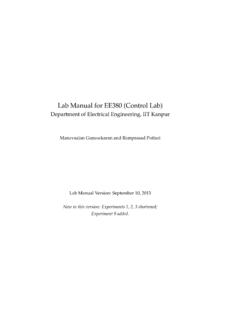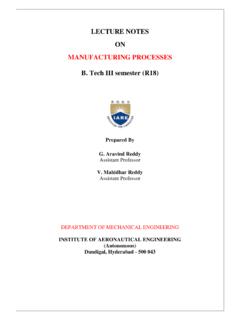Transcription of Module 7 Simple Beam Theory - Massachusetts Institute of ...
1 Module 7 Simple beam TheoryLearning Objectives Review Simple beam Theory Generalize Simple beam Theory to three dimensions and general cross sections Consider combined effects of bending, shear and torsion Study the case of shell Review of Simple beam theoryReadings: BC 5 Intro, beam is a structure which has one of its dimensions much larger than the other importance of beam Theory in structural mechanics stems from its widespread successin practical Kinematic assumptionsReadings: BC Theory is founded on the following two key assumptions known as the Euler-Bernoulli assumptions: Cross sections of the beam do not deform in a significant manner under the applicationof transverse or axial loads and can be assumed as rigidConcept Question reference to Figure ,1.
2 What is the main implication of this assumption on the kinematic description(overall displacement field) of the cross section?9192 Module 7. Simple beam THEORYe2e3e1u2u3 Figure : First kinematic assumption in Euler-Bernoulli beam Theory : rigid in-plane de-formation of cross To simplify further the discussion, assume for now that there is no rotation of thecross section around thee3axis. Write the most general form of the cross-sectionin-plane displacement components: During deformation, the cross section of the beam is assumed to remain planar andnormal to the deformed axis of the Question reference to Figure ,1. what is the main implication of this assumption on the kinematic description(overall displacement field) of the cross section?
3 2. Based on these kinematic assumptions, write the most general form of the cross-section out-of-plane displacement component:3. If you noticed, we have not applied the constraint that the sections must remainnormal to the deformed axis of the beam . Use this part of the assumption toestablish a relation between the displacements fields u2(x1), u3(x1) and the anglefields 2(x1), 3(x1), respectively, see Figure??.Concept Question the results from all the kinematic assumptions toobtain a final assumed form of the general 3D displacement field in terms of the threeunknowns u1(x1), u2(x1), u3(x1) REVIEW OF Simple beam THEORY93e2e3e1(a)e2e3e1 2(x1)(b)e2e3e1 3(x1)(c)Figure : Second kinematic assumption in Euler-Bernoulli beam Theory : cross sectionsremain planar after 7.
4 Simple beam Theory 2u3(x1)e1e3bc+e2(a) 3u2(x1)e1e2bcbe3(b)Figure : Implications of the assumption that cross sections remain normal to the axis ofthe beam upon assumptions have been extensively confirmed for slender beams made of isotropicmaterials with solid Question the kinematic assumptions of Euler-Bernoulli beam theoryto derive the general form of the strain field:Concept Question is important to reflect on the nature of the strains due tobending. Interpret the components of the axial strain 11in Euler-Bernoulli beam theoryOne of the main conclusions of the Euler-Bernoulli assumptions is that in this par-ticular beam Theory the primary unknown variables are the three displacement functions u1(x1), u2(x1), u3(x1) which are only functions ofx1.
5 The full displacement, strain and there-fore stress fields do depend on the other independent variables but in a prescribed way thatfollows directly from the kinematic assumptions and from the equations of elasticity. Thepurpose of formulating a beam Theory is to obtain a description of the problem expressedentirely on variables that depend on a single independent spatial variablex1which is thecoordinate along the axis of the Definition of stress resultantsReadings: BC resultants are equivalent force systems that represent the integral effect of theinternal stresses acting on the cross section. Thus, they eliminate the need to carry over thedependency of the stresses on the spatial coordinates of the cross sectionx2, AXIAL LOADING OF BEAMS95 Theaxial or normal forceis defined by the expression:N1(x1) = A 11(x1,x2,x3)dA( )Thetransverse shearing forcesare defined by the expressions:V2(x1) = A 12(x1,x2,x3)dA( )V3(x1) = A 13(x1,x2,x3)dA( )( )Thebending momentsare defined by the expressions:M2(x1) = Ax3 11(x1,x2,x3)dA( )M3(x1) = Ax2 11(x1,x2,x3)dA( )( )The negative sign is needed to generate a positive bending moment with respect to axise3,see Figure e2 13 11 11 13dx1N1V2M3N1V2M3e1e2bcbe3 12 11 11 12 Figure : Sign conventions for the sectional stress Axial loading of beamsReadings.
6 BC the case where there are no transverse loading on the beam , Figure Theonly external loads possible in this case are either concentrated forces such as the loadP1,or distributed forces per unit lengthp1(x1).96 Module 7. Simple beam THEORYLp1(x1)P1e1e2 Figure : Beams subjected to axial KinematicsIn this case, we will assume that the cross sections will not rotate upon Question on this assumption, specialize the general displacement(??) and strain field (??) to this class of problems and comment on the implications of thepossible deformations obtained in this Constitutive law for the cross sectionWe will assume a linear-elastic isotropic material and that the transverse stresses 22, 33 Hooke s law, the axial stress 11is given by: 11(x1,x2,x3) =E 11(x1,x2,x3)Replacing the strain field for this case: 11(x1,x2,x3) =E u 1(x1)( )In other words, we are assuming a state of uni-axial Question exposes an inconsistency in Euler-Bernoulli beam is it and how can we justify it?
7 The axial force can be obtained by replacing ( ) in ( ):N1(x1) = A(x1)E u 1(x1)dA= A(x1)EdA S(x1) u 1(x1)We will define:S(x1) = A(x1)E(x1,x2,x3)dA( ) AXIAL LOADING OF BEAMS97as theaxial stiffnessof the beam , where we allow the Young s modulus to vary freely bothin the cross section and along the axis of the beam , and we allow for non-uniform crosssection geometries. In the case that the section is homogeneous in the cross section (E=E(x1, x2, x3)), we obtain:S(x1) =E(x1)A(x1) (This may happen for example in functionally-graded materials). Further, if the section is uniform alongx1and the material is homogeneous(E=const), we obtain:S= can then write a constitutive relation between the axial force and the appropriatemeasure of strain for the beam :N1(x1) =S(x1) u 1(x1)( )e3e2xi3xi+13i=n,Eni,Eii= 1,E1wFigure : Cross section of a composite layered Question loading of a composite beam1.
8 Compute the axial stiffness of a composite beam of widthw, which has a uniform crosssection withndifferent layers in directione3, where the elastic modulus of layeriisEiand its thickness isti=xi+13 xi3, as shown in the Compute the stress distribution in the cross section assuming the axial force distribu-tionN1(x1) is known:3. Interpret the stress distribution 7. Simple beam THEORYH aving completed a kinematic and constitutive description, it remains to formulate anappropriate way to enforce equilibrium of beams loaded Equilibrium equationsdx1N(x1) +N (x1)dx1N(x1)p1(x1)dx1e1 Figure : Axial forces acting on an infinitesimal beam structural elements, we seek to impose equilibrium in terms of resultant forces (ratherthan at the material point as we did when we derived the equations of stress equilibrium).
9 To this end, we consider the free body diagram of a slice of the beam as shown in Atx1the axial force isN1(x1), atx1+dx1,N1(x1+dx1) =N1(x1) +N (x1)dx1. Thedistributed force per unit lengthp1(x1) produces a force in the positivex1direction equal top1(x1)dx1. Equilibrium of forces in thee1direction requires: N1(x1) +p1(x1)dx1+N1(x1) +N (x1)dx1= 0which implies:dN1dx1+p1= 0( ) Governing equationsConcept Question Derive a governing differential equation for the axially-loaded beam problem by combining Equations ( ) and ( ).2. What type of elasticity formulation does this equation correspond to?3. What principles does it enforce? AXIAL LOADING OF BEAMS99 Concept Question derived equation requires boundary How many boundary conditions are required?
10 2. What type of physical boundary conditions make sense for this problem and how arethey expressed mathematically?This completes the formulation for axially-loaded : Schematic of a helicopter blade rotating at an angular speed Concept Question blade under centrifugal loadA helicopter blade oflengthL= 5mis rotating at an angular velocity = 600rpm about thee2axis. Theblade is made of a carbon-fiber reinforced polymer (CFRP) composite with mass density = 1500kg m 3, a Young s modulusE= 80 GPaand a yield stress y= 50 MPa. The areaof the cross-section of the blade decreases linearly from a valueA0= 100cm2at the root toA1=A0/2 = 50cm2at the give the expression of the distributed axial load corresponding to the centrifugal force2.












